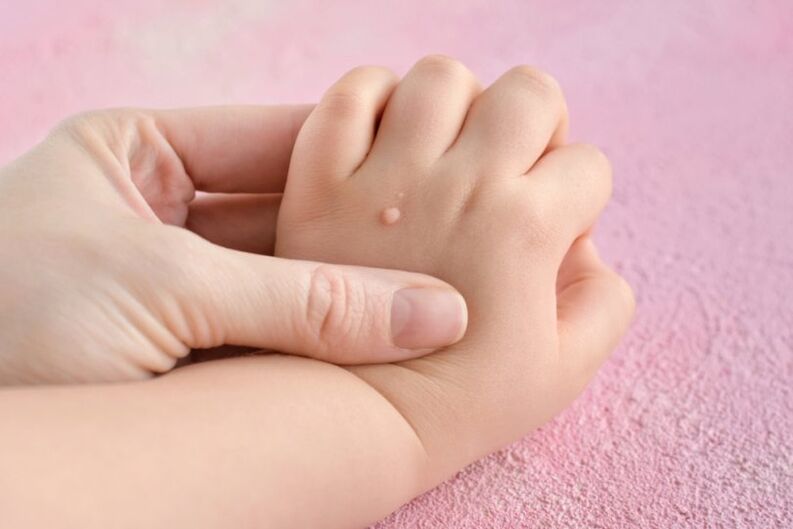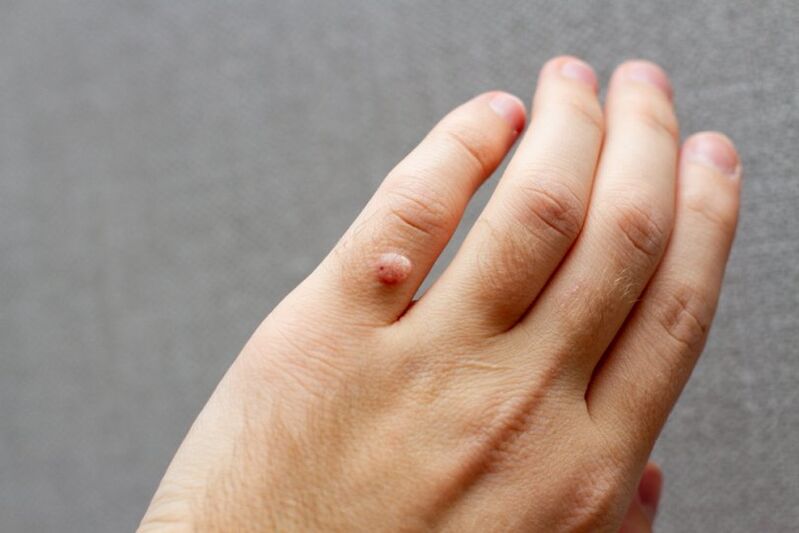A wart is a harmless structure like a rounded elevation on the skin, which is caused by a strong growth of the surface epithelium and papillary layer.
In most cases, the proliferation of cells is caused by HPV, caused by external and internal factors - confusion, decreased immunity, for some types - increased sweating of the limbs. You can get HPV through contact with carriers and objects. This does not apply to senile warts - their occurrence is non-viral in nature.



The sizes of the formations vary from 1 to 15 mm on average (old ones reach 6 cm). Their surface is uneven, so they get dirty easily, and therefore, over time, they can change color from almost flesh to brown. Multiple units can form groups when they are close together. All warts can be removed. In some cases, the doctor may decide to observe without removal if the patient is comfortable.
When to see a doctor urgently:
- Education is located in the genital area;
- itching, discharge is observed in the area of the tumor;
- heterogeneous color, there are spots;
- it changes shape and color;
- because the location is injured in everyday life;
- you won't believe it's a wart.
Types of warts
There are 4 types:
- ordinary (simple) - created by hand (within the subgroup - foot);
- flat - usually found in young people, so the second name of flat warts is youth;
- acute - infection with HPV types that appear in the genital area;
- old age - the causes are unknown, it is not caused by HPV, it appears in middle-aged and older people.
Normal warts are 1-10 mm in size, dense, keratinized. The average life of such a structure is about 2 years, after which it resolves itself. The most common localization site is the brush.
Plantar warts are formations on the feet, which at first look like a small callus, then a rough surface with black dots in the center and a small roller appears on the edge. Corneal formations cause discomfort, as they cause pain when the patient walks. They can cause loss of mobility and performance. Removal of plantar warts greatly improves quality of life.
Flat warts have clear boundaries, are small in size - up to 5 mm, and rise slightly above the skin surface by 1-2 mm. Any shape - round or irregular. Skin irritations, scratches, and cuts can irritate the appearance. Favorite places to localize this type of structure are the face, hands, and feet.
Genital warts are located in the genitals. They are treated by removal and very quickly, because they acquire a large size. Infection occurs sexually, and its probability is higher when there are wounds in the groin. Condylomas are pink nodules that merge to form papillary growths with stalks attached to the body.
Senile warts (seborrheic keratosis) are listed in the only non-HPV-related category. We can often talk about a genetic predisposition related to a positive family history. Forms can reach a very large size - up to 4-6 cm (average size - 0, 2-3 cm). They produce seeds in groups of up to 20 units. The most common places of localization are the chest, face, neck, wrists, hands.
Initially, the elements are flat and small, with an uneven surface. They are covered with easily removable shells. After that, the bark becomes denser, drier, and covered with cracks. Over time, their thickness can be 1-2 cm. With age, they take on the shape of a mushroom cap, and although they are initially light yellow or pink in color, they darken. They contain impurities. Formations never become cancerous.
Eradication of warts
Wart treatment is selected individually by the doctor depending on its type, size, contraindications and other aspects. The clinic offers 4 ways to remove warts, papillomas and condylomas:
- using a radio wave scalpel;
- laser CO2 extraction;
- cryodestruction;
- diathermocoagulation.
They are suitable for removing flat and raised warts. Unfortunately, none of the recommended methods can eliminate HPV from the body, which makes it 30% likely to recur. Also, no method is 100% guaranteed, additional procedures may be required. Scars may remain after removal, and choosing the right clinic and technique can help prevent this. Experienced dermatologists in a professional clinic and high-quality equipment manufactured according to modern standards are a combination that ensures high-quality care, pain relief and quick recovery. There is infiltration and application anesthesia.
laser removal
The laser creates a high-energy beam of light that causes a sharp increase in temperature in the tissue. The advantages of laser removal of papilloma and warts are the absence of bleeding, blisters, and large scars. The procedure lasts 5-7 minutes. Typically, devices are deleted first.
Eradication of warts is carried out according to the following plan:
- skin treatment with antiseptic;
- anesthetic treatment (injection or ointment);
- treatment of papilloma on the entire face;
- treatment and dressing of the resulting wound.
Cryodestruction
Treatment is carried out with liquid nitrogen. This procedure is used in the removal of a wide range of tumors and even in the treatment of internal organ tumors, cervical diseases, and liver surgery. Under the influence of low temperature, the water inside the cells freezes and the cell bursts and dies.
Removal Procedure:
- anesthesia (if it is large, then it is located in the area with thin skin);
- exposure with a cotton swab soaked in liquid nitrogen (5-30 seconds depending on the size);
- Wait 2 minutes. Examination. If necessary, repeat the procedure.
The next day, a blister will appear on the skin, which will gradually pass. The patient's responsibility is not to damage the foam prematurely, to wash it gently, not to patch it, and to protect it from external influences.
Diathermocoagulation
This treatment method involves cauterization of tissues using high-frequency current, contact and non-contact methods. The procedure is carried out with the help of EKhVCh (high-frequency electrosurgical device). Its difference from the "Surgitron" radio wave scalpel is the use of high-frequency current - about 400 kHz (up to 4 MHz in a radio knife). The method allows bloodless coagulation of the skin and effectively cope with the structure.
radio wave scalpel
As a radio wave scalpel, Surgitron, which operates on radio waves with a frequency of 3. 8-4. 0 MHz, is used to remove warts. The wave vaporizes the targeted cells and does not affect its neighbors. Most often, this method is used on the face, neck, and genitals due to its delicacy. Advantages also include high speed, no bleeding, minimal swelling, and quick healing.
The operation is carried out as follows:
- the skin is treated with an antiseptic;
- anesthesia (injections, creams) is performed;
- the doctor takes a waveguide of any shape and removes the neoplasm;
- antiseptic treatment.
Make an appointment with a dermatologist
The NEARMEDIC network of clinics offers several effective methods for the removal of plantar warts, including flat, pointed, senile, and common. An inexperienced person can confuse a wart with other tumors that can turn into a malignant form - before treatment, you should consult a dermatologist.
In our clinic, you can consult with experienced dermatovenerologists, candidates of medical sciences and doctors, even in difficult cases. You can find the names, photos and biographies of all the specialists on the site with their place of admission. Here you can make an appointment with a specific doctor.
Removing the visible manifestations of the problem is not enough to reduce the likelihood of relapses. For this, general therapy with antiviral drugs that reduce the activity of human papillomavirus is used. The doctor conducts a complete diagnosis, develops a treatment plan, advises on all types of removal and recommends the most effective one in a particular case. Consult a specialist at the first signs of illness.
The price of admission and withdrawal of the doctor is shown in the table. Note that it is cheaper to remove 2 to 5 or more forms. Call or use the form on the website to schedule an appointment.














































































